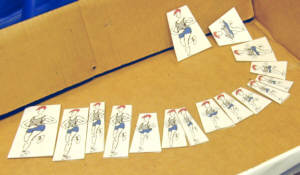|
The logician's notion of implication is a genuine troublemaker. Hear what sounds like shoddy thinking, but some error or another which you can't quite put your finger on, and it's probably an error in the use of an implication relationship. A physicist claims physics underlies all other topics making those topics "in principle" derivable from physics. A New Age amateur philosopher declares physics to be not worth studying because it has nothing much to say about love, art, or passion. Actually, physics is necessary to any complete description of anything physical, but it isn't sufficient to describe or predict everything. The physicist claimed sufficiency on the basis of necessity. The New Ager claimed lack of necessity on the basis of lack of sufficiency. That's two versions of the same error. Necessity and sufficiency are both implications, each the inverse of the other. By confusing the two, the physicist and the New Ager are both improperly inverting implications. A politician rejects doing anything about some issue, arguing, "We can't solve all the problems there." He's confusing some with all and that improperly inverts an implication -- he's not just expressing a bit of hyperbole which invoking "free speech" lets him get away with. In the 1970's Percy C Wason stirred up a heap of interest in how people do and don't properly interpret implications with a large study of the card selection puzzle in the column to the right. Very few people get it correct immediately. Some never quite seem to grasp the answer. A lot has been published about this gem of "simple but subtlle," but nothing beats actually observing and experiencing the subtleties of the puzzle. |
The logician's way of expressing implication: Note that "implication" has another meaning that is much less abstract and much more common. To imply is to state indirectly requiring the listener to do a bit of figuring. The logician's implication is one of those abstractions that relates a lot of disparate phenomena. Learn to recognize it, and we gain a bit of magic. |
|
Extremely simple; extremely subtle  (From the video tape made at Da Vinci
Days 2004.)
The
tale continues here. Discussions
from several diffrent perspectives.
When Marylin vos Savant discussed this puzzle in her weekly Parade column, the majority of professional mathematicians who wrote her claimed her thinking was wrong. But it was that majority who was wrong. The chair of the Math Department at Oregon State Univ. wrote to point out that mathematics is not a democracy with majority rule: She was right! "Switch" is the correct answer, and the many mathematicians who set up a computer simulation of the puzzle discovered that the simulation agreed. This puzzle is a great brain sharpener! |
Observation, data, evidence. Science starts there because science is preparation for interacting with the world around us. We must first look at that world. The power of observation, evidence-testing and data-organizing as practiced in science is often not recognized. That's one of the slip-ups made by many at Da Vinci Days while facing Monty Hall. Statistics is one of the most powerful tools of the modern thinker. Lotteries and casinos would not exist if substantial numbers of people understood the "Once you see it, you can never again not see it." aspect of statistical reasoning. The better and better we see it, the more and more we see examples in day-to-day experience. Ignorance is a part of life and a central aspect of statistics. You started completely ignorant of which box the ducky was in, so the odds were 1/3 for each of the boxes (unless you had fallen under the temptations of a shell-game artist version of Monty Hall: they easily move the ducky from place to place right under your eyes). But when he showed you the empty box, he told you something he had known and you hadn't. You lost a lot of ignorance at that point. The statistics had changed, and your thoughts must follow the change. |
|
or colors or ellipses or...  However, "Which athlete is bigger?" is almost always answered by trying to put them in a line to determine their relative positions on the line. The error of this way is easy to see when we realize that the football coach wants the heaviest and the basketball coach wants the tallest. It depends on what the information is for. Thinking in the one dimension of a line is easy. Thinking in the two dimensions of a plane is much more subtle, and taking that to spaces of three, four, five, and more dimensions can really challenge us. Yet most of the world lies, in many different ways, in spaces of many dimensions. That only the beginning. An engineer, even an physicist, might recognize that here the thinking has gone from "scalar" (line) to "vector" (space). The next step is "tensor," and that brings up Richard Feynman's wonderful warning: Physicists always have a habit of taking the simplest example of any phenomenon and calling it "physics," leaving the more complicated examples to become the concern of other fields... Since most of you are not going to become physicists, but are going to go into the real world...sooner or later you will need to use tensors. The Feynman Lecture
on Physics Vol II, p 31-1
Links to some further considerations:
Arrange the Athletes |
The world of multidimensional thought is vast and seldom recognized. The magic of multidimensional relationships is powerful and can lead to unforseen marvels. (Several of the first Nobel Prizes in Economic Sciences went to people wielding this magic.) Think about the cost of a ticket you buy at Ticketmaster. Which should cost more a lecture by a Nobel laureate, a lecture by Jane Goodall, a concert by the Oregon Symphony, a concert by a loud hard rock band, a talk by President Bush, a talk by the Pope, a talk by Hugo Chavez, a golf lecture by Tiger Woods, a 50-yard line seat at the next Superbowl game, a talk by Monica Lewinski? Etc. Etc. Etc. What would you forgo to attend each of these? Some meals? Some needed medical attention? A trip to some place you always wanted to go? A walk along the Eastbank Esplanade? The values represented here are many and extremely varied, ranging among the individual and the societal, the competing and the mutually reinforcing. Evaluating and comparing such values is a multidimensional task. Good multidimensional imagination is necessary to avoid confounding things that must be understood as separate and perhaps even unrelated. The math term, "orthogonal." is a valuable
notion here. So is "oversimplification" because that's the
trap we fall into when we limit ourselves to those linear arrays.
Arranging colors is harder than...
...help!!
|

